Top 7 Famous Temples in Varanasi You Can’t Miss
Famous Temples in Varanasi: Varanasi, also called Kashi or Banaras, the city of Lord Shiva, is believed to achieve liberation.…
 0%
0%

The Pancha Bhoota Sthalams are ancient Hindu temples dedicated to Lord Shiva, the God of Gods.
Located in the South Indian state, each temple symbolizes one of the five elements of nature: Earth, Water, Fire, Air, and Ether. It is believed that all creation within the universe is composed of these elements.
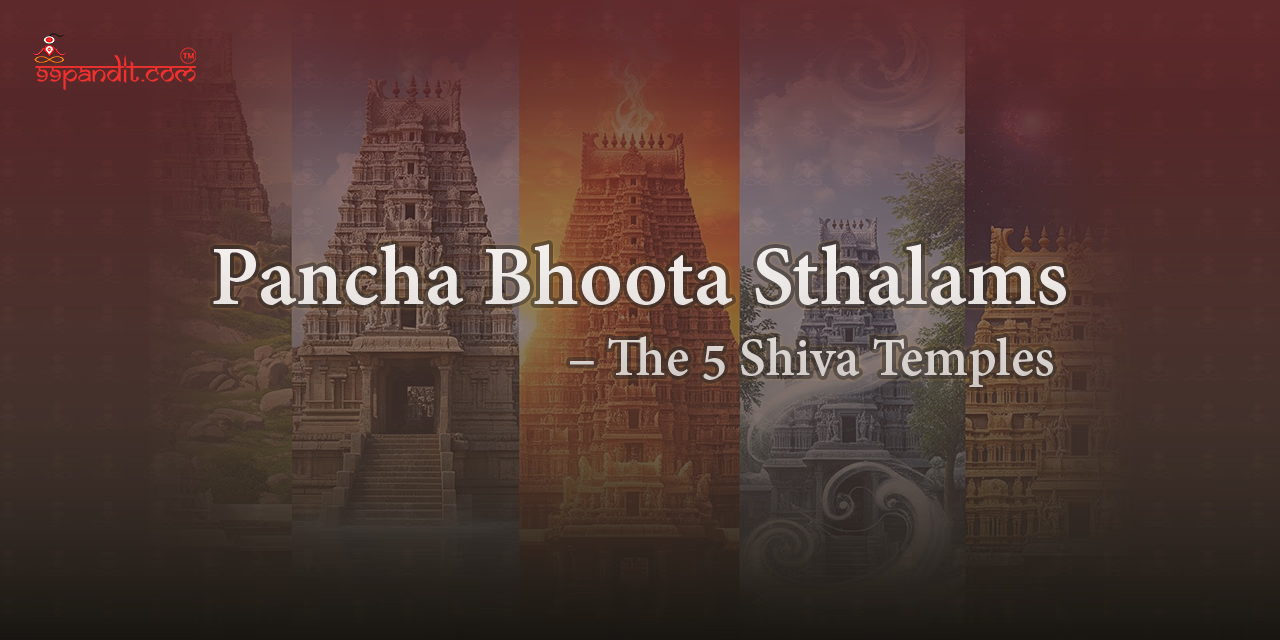
These ancient architectural wonders stand as the guardians of these five elements, each with a holy Lingam representing its natural energy.
In addition to the crescent moon and tangled hairs, Shiva is the eternal yogi, the complete balance of these cosmic energies.
Visiting the temples has the ability to realign mind, body, and soul and charge you with centuries of history, spirituality, and beliefs.
This article will take you on a journey through Pancha Bhoota Sthalams. We will discuss their significance, the mythical story behind them, and much more.
Pancha Bhoota Sthalams are the five ancient Shiva temples that represent different aspects of natural elements.
In Sanskrit, “Pancha” refers to five, “Bhoota” means all five elements, and “Sthalams” refers to place.
Lord Shiva is widely worshipped in different parts of India, but in South India, he is revered as the presiding deity of the five elements of nature.
In this form, He is called Bhootapati or Bhootnath – the Lord of the Elements. Here, Lord Shiva is worshipped in a Lingam shape representing a specific nature element.
Similar to the display of the Earth element at the Ekambareswarar Temple, all five temples are very significant in Hindu mythology and religious rituals.
Bhoota Sthalams are believed to be a means to be with nature, look for balance, and advance devotion to Lord Shiva. South India houses four of them in Tamil Nadu and one in Andhra Pradesh.
People are amazed that these temples are geographically aligned in almost a straight line and said to have been built centuries ago.
A perfect alignment and mix of astronomy and engineering make them a true wonder. Every temple has its own story to tell, with the essence of spirituality.
Here’s a quick look at the famous Pancha Bootha Sthalams:
| Temples | Locations |
| Ekambareswarar Temple | Kanchipuram |
| Jambukeswarar Temple | Thiruvanaikaval |
| Arunachalesvara Temple or Annamalaiyar Temple | Tiruvannamalai |
| Sri Kalahasti Temple | Srikalahasti |
| Thillai Nataraja Temple | Chidambaram |
Location: Kanchipuram, Tamil Nadu
Element: Earth (Prithvi)
Ekambareshwarar Temple in South India is one of the largest temple complexes in Kanchipuram. It’s a temple devoted to Lord Shiva and has Dravidian-type architecture.
The temple is encircled by a huge temple tank and green surroundings. The Shiva lingam of the Earth element is formed with sand in this temple.
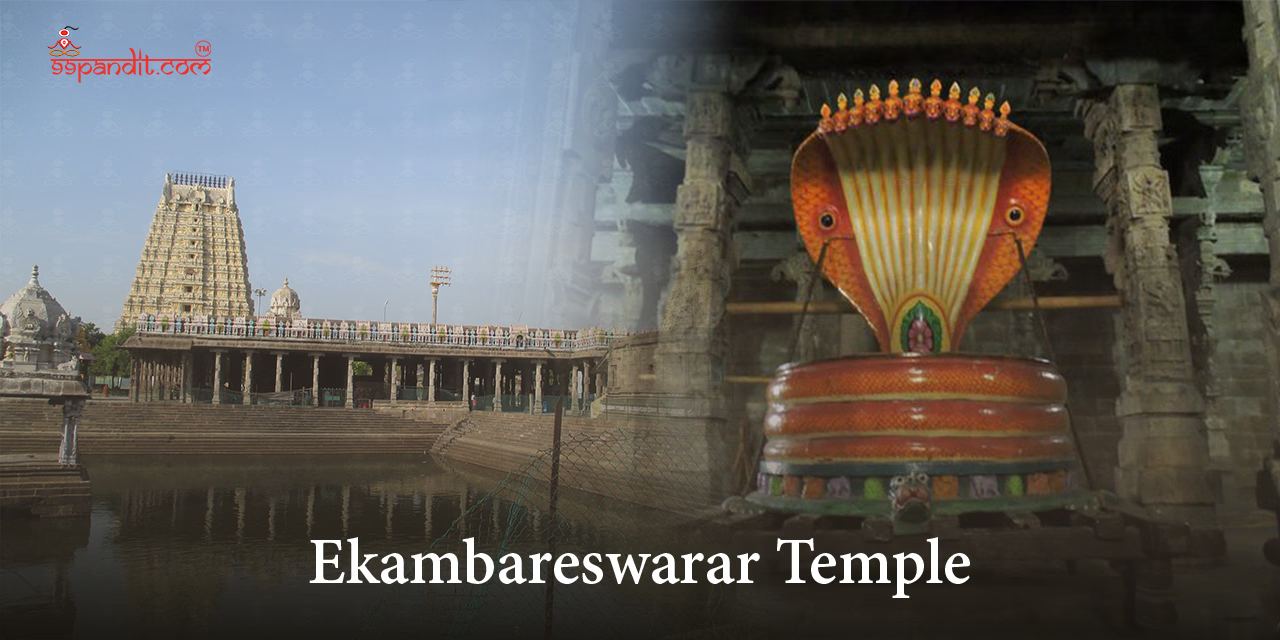
A scarred mango tree in the temple courtyards caught the attention of many and was believed to be over 3,500 years old.
Devotees all over the world visit this holy site seeking a sense of stability and worshipping this lingam, which is said to remove all the obstacles from life. The divine energy and calm atmosphere bring peace and strengthen the visitors.
According to legends, Goddess Parvati, to get back to Lord Shiva, formed a Shiva Lingam from the sand of the Earth beneath the divine mango tree at this location. To test her faith and devotion, Lord Shiva sent Maa Ganga to trouble her.
But Parvati convinced Maa Ganga not to harm her and agreed not to disrupt her penance. Impressed by her devotion, Lord Shiva accepted her wish and got married.
The temple and a mango tree are a testament to their pure love, and it is said that whoever prays to this Earth lingam gets spiritual blessings from God.
Being the largest temple in Kancipuram, it is famous for its massive gopuram (entrance tower), which stands nearly 60m tall.
The hall of the temple has over 950 carved pillars displaying Chola dynasty architecture.
Moreover, other than the main lingam, there is the Sahasra Lingam that contains 1008 smaller lingams carved on it.
Visiting between the months of February to April is considered good, as this time you can also experience the festivals such as the Panguni Uthiram.
The morning hours are 6:00 AM to 11:00 AM, and the evening hours are 5:00 PM to 8:30 PM.
Location: Thiruvanaikaval, Tamil Nadu
Element: Water (Apas)
Jambukeshwar Temple is another Pancha Bootha Sthalam located in Thirvanaikaval, two kilometres from the famous Rangan Temple.
It represents the water element and is renowned for its amazing architectural style and sacred water tank. The Lingam of Shiva here is called Appu Lingam.
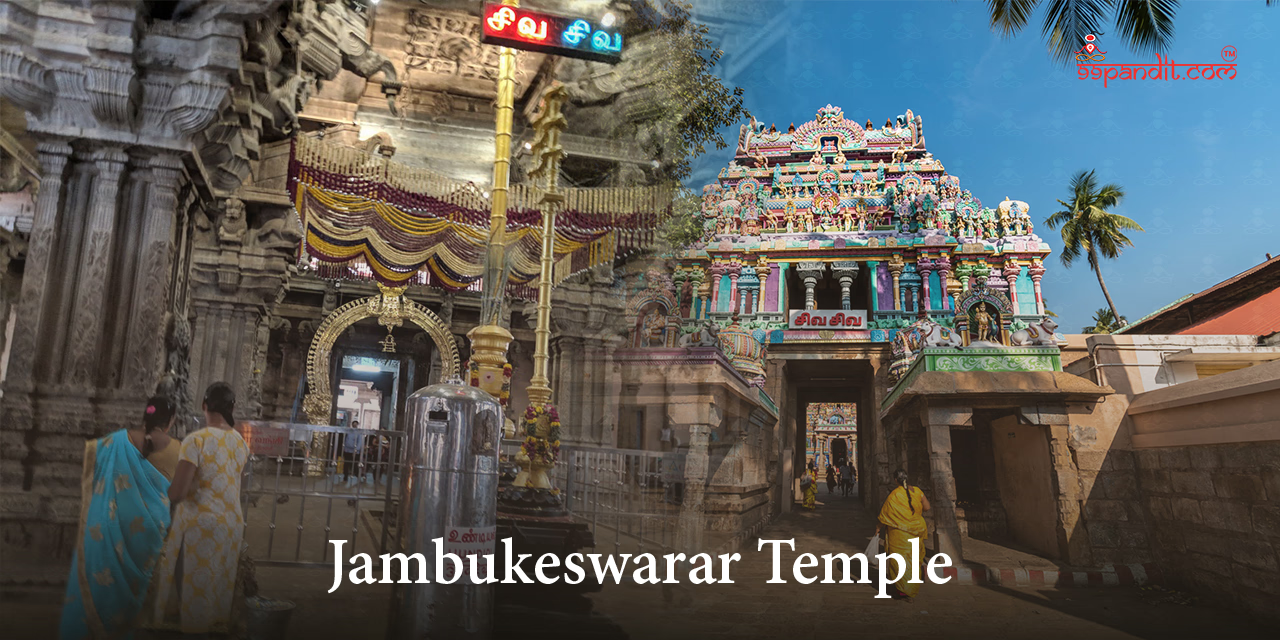
According to the legends, it is said to have been constructed by Kocenganna Chola around 1800 years ago. The temple is ranked the 13th largest in India and covers over 18 acres of land.
The lingam of the temple is partially surrounded by water, a potent symbol of purity and fluidity that depicts the dynamic character of life.
As per the story, Goddess Paravati took the form of Akilandeshawri and found a Jambu tree to perform her penance.
She made a Lingam out of water and worshipped Lord Shiva. Impressed by her devotion, Lord Shiva appeared and taught her Shiva Gana.
Since then, this temple has held the essence of the Guruji-shiysa relationship. Even today, priests of this temple dress up like women and offer prayers to Lord Shiva as a symbolic portrayal of Goddess Akhilandeshwari’s worship.
The temple is an architectural beauty with a magnificent hall and sanctum with an unending water supply through a subterranean source.
It is among the 275 Paadal Petra Sthalams, which means it is glorified in the hymns by the four greatest Saivite saints, referred to as Nayanars. The free air and sacred tanks double the charm of the sacred spot.
If you plan to visit the Jambukeshwar temple, it is best to visit during February and March. This is when most of the grand events are enjoyed, like the Natyanjali dance festival.
Location: Thiruvannamalai, Tamil Nadu
Element: Fire (Agni)
Arunchaleswarar Temple, or Annamaliyar Temple, is a beautiful temple located at the base of Mount Arunachala in Thiruvannamalai.
It is one of the Pancha Bhoota Sthala, where Lord Shiva is said to have manifested in the form of a ray of light, representing the element of fire.
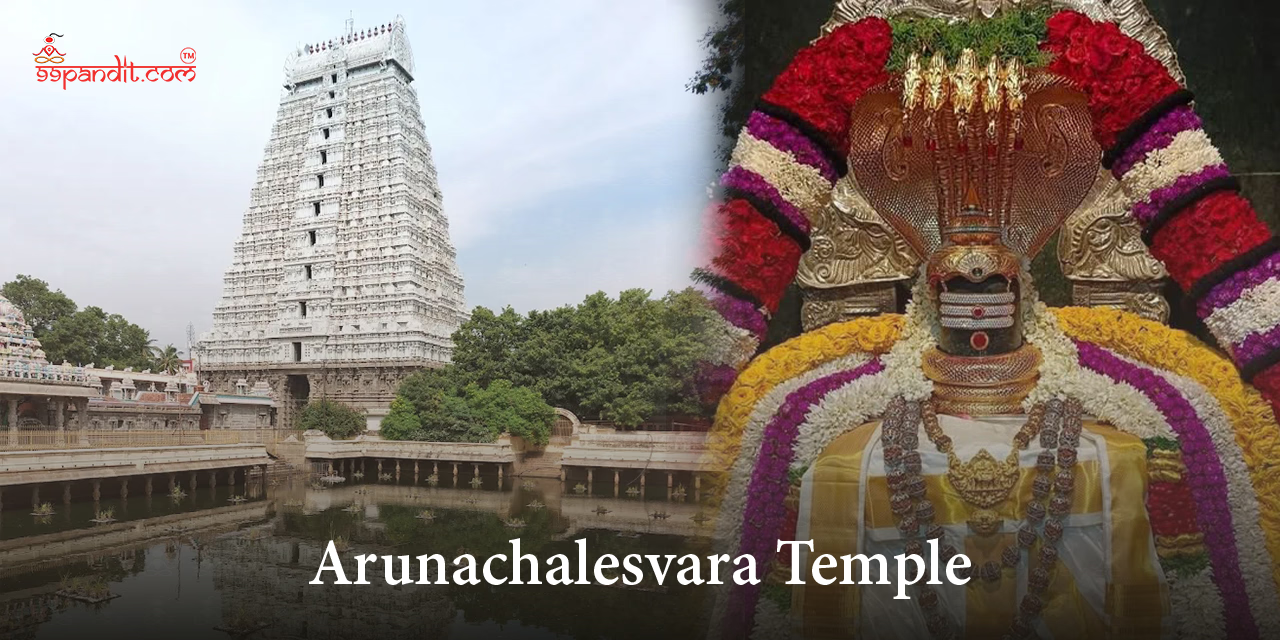
It occupies eighth position as one of the biggest Hindu temples in the world, and it is one of the most frequented places in Tamil Nadu.
Glimmers of the divine power and the history of this temple attract thousands of worshippers annually, seeking perfection and God’s salvation.
The large temple structure and the tranquil surroundings offer a comfortable environment.
A long time ago, Lord Vishnu and Brahma had a battle over who was the superior god of the two.
That’s when Lord Shiva manifested himself as an infinite column of fire and challenged them to find the end or the start.
While Lord Vishu admitted defeat, Brahma lied about finding it. Outraged, Lord Shiva cursed Brahma that no one would worship him. This is the reason for the appreciation of the Lingodbhava form of Shiva.
Even now, as a part of the festival of Karthigai Deepam, a large fire is lit somewhere on the heights of Arunchala hill, to show the immense light of knowledge.
The temple stretches over 25 acres and has Dravidian-style architecture. It was built in the 9th century by the Chola dynasty, and the Vijaynagar dynasty added an expansion.
It contains four main gateways, known as gopuram, and all these are surrounded by shrines, mandapams, and chambers, decorated with sculptures and carved.
Additionally, the thing that caught the attention of many is that its gopuram on the eastern side is 66 meters tall.
Plan your trip between the months of October to March at Arunachaleswarar Temple is best as weather is quite lovely.
The temple’s hours are in the morning from 5:30 AM to 12:30 PM and in the evening from 3:30 to 9:30 PM.
Location: Srikalahasti, Andhra Pradesh
Element: Air (Vayu)
Srikalahasteeswara Temple, or Sri Kalahasti, is a sacred place in Andhra Pradesh. It is dedicated to Lord Shiva, who symbolizes the air aspect.
The view of the temple presented to the visitors is magnificent as the Swarnamukhi River flows by its sides, and around it are mountains.
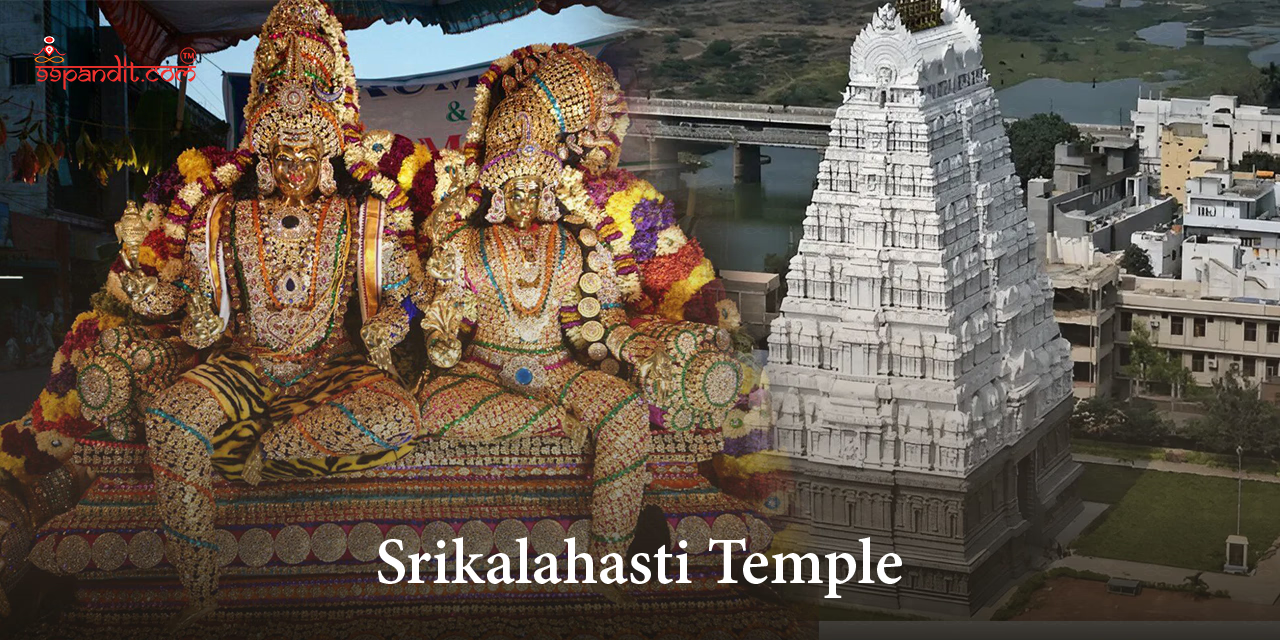
The temple is believed to be linked with the Rahu and Ketu, which are some of the key aspects of Indian astrology.
The temple is also renowned for rituals concerning horoscopes, such as the fascinating Rahu Ketu Sarpa Dosha Nirvana Pujas.
It is also a shrine house of Goddess Parvati, who is referred to as Gana Prasunambika Devi.
Devotees of Lord Shiva come to the sacred place to attain blessings for spiritual enlightenment and to achieve clear thinking.
The mythological legend related to this temple is mingled in the narration, where a spider (Sri), a snake (Kala), and an elephant (Hasti) offer Shiva services in their own style.
They are all liberated despite the numerous differences in their worship. The narration describes how dedication and identity are above all others. Also, it is regarded as a very favourable location to clear old karma.
The temple of Sri Kalahasti is nearly 36 km distant from the famous temple of Tirupati.
It is alleged to have been constructed in the 5th century and thereafter changed by the Chola and Vijayanagar kings in the 12th century.
The temple is renowned for its remarkable architectural design and white Vayu Lignam.
It is believed that this lingam is self-manifested (Swayambhu). No one can touch this holy lingam, neither the devotees nor the priests.
If you wish to be a part of a grand celebration such as Maha Shivratri, you may go in February or March.
In the morning, the darshan time is between 6:00 AM – 1:00 PM and during the evening, 4:00 PM – 9:00 PM.
Location: Chidambaram, Tamil Nadu
Element: Ether (Sky)
As the name of the temple itself indicates, the Thillai Nataraja temple is located in honour of Lord Shiva in his form of dancing and Lord Govindaraja Perumal (Vishnu).
It is one of the few temples where Shavite and Vaishnavite gods coexist. The Lord Shiva lingam at Chidambaram represents the Ether element and is said to be 1000 years old.
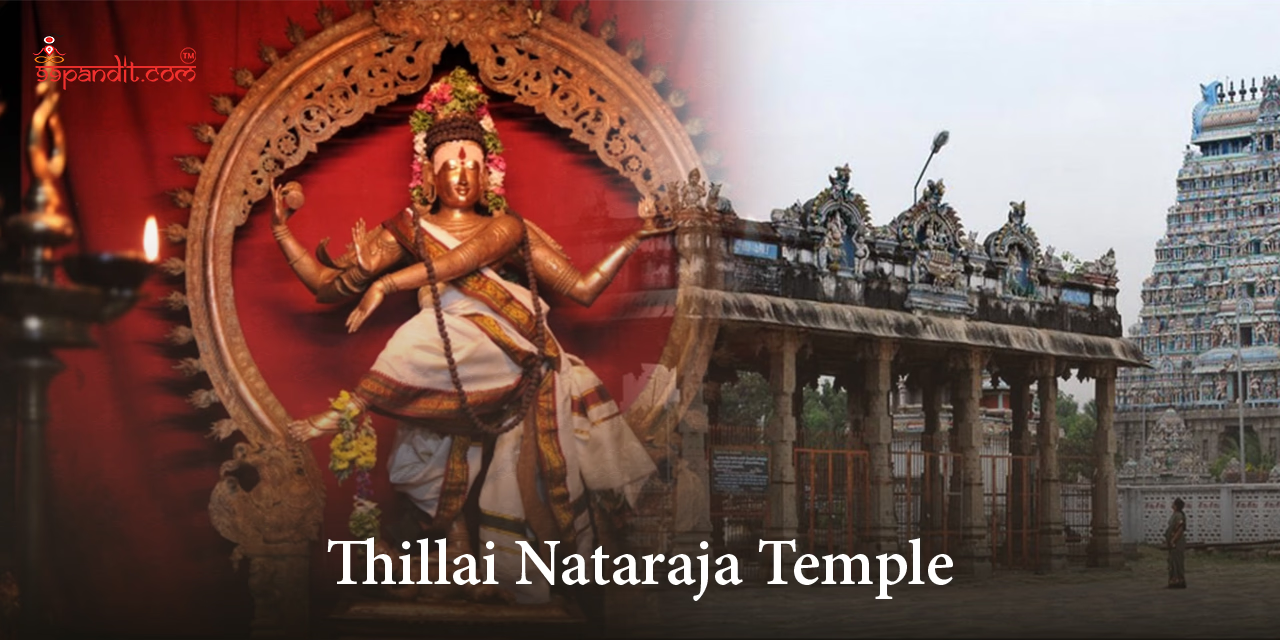
The word “Chidanbaram” is derived from the word “Chit”, which refers to consciousness, and “Ambaram” means sky. Together, they mean “Sky of Consciousness”, which is the supreme goal of human life.
It is the only temple among the Pancha Bhoota Sthalam, where Lord Shiva is depicted in an anthropomorphic idol rather than the Lingam. Here, Lord Shiva is also worshipped in his formless form.
The story of this temple revolves around Lord Shiva Natarajan’s form. Once, Lord Shiva, with Lord Vishnu in the form of Mohini, walked around the Thillai forest.
The sages living in this forest believed in the magic that could control God through rituals and mantras.
Their wives were delighted by the beauty of Lord Shiva and Vishnu. On seeing this, the sages got angry and invoked scores of snakes.
Lord Shiva lifted them and wore them as an ornament around his neck. After that, they sent a tiger, which Lord Shiva skinned and wore as a shawl.
Then the rishi invoked Muyalakan, who represents arrogance and ignorance. Lord Shiva crushed the demon under his feet, performed Urdhva Tandav, and disclosed his real form to everyone.
The Thillai Natraj Temple was built in the 10th century and covers 20 hectares of the city area.
Its design is created in Chola-Pandyan style and includes 9 Gopurams, among which one is made of gold-plated by the Chola King Parantaka.
Plus, inside the temple, you will also see detailed carvings of Bhratnatyam postures on the walls.
The ideal time to go to this temple and have the blessings of Lord Shiva in the Nataraj avatar is from December to February. Morning is from 6:00 AM to 12:00 PM, and evening is from 5:00 PM to 10:00 PM.
A trip to the Pancha Bhoota temples will not only give you inner peace but also tie you with cosmic forces and spirituality.
In case your trip also includes visiting the Lord Shiva temple, then the tips below will offer you a hassle-free journey:
The Pancha Bhoota Sthalams are the five Shiva temples, and in every one of them, a particular element of nature is represented.
These are air, water, earth, fire, and ether, and all creations in the world are said to have these in them.
These lovely temples not only demonstrate the superiority of Lord Shiva but also the faith people have in him.
Each one of them is the symbol of a specific element, meaning, and their individual stories.
The divine powers and awe-inspiring architecture with historicity make this sacred place a once-in-a-lifetime destination.
These pancha bhoota temples not only give you an otherworldly experience but also touch your lives with the energies of Lord Shiva. That’s it for 99Pandit today. I hope you liked this article on Pancha Bhoota Stalams.

100% FREE CALL TO DECIDE DATE(MUHURAT)

Table Of Content
Filters by categories
All Pujas
Puja On Special Events
Upcoming Pujas
Dosha Nivaran Pujas
Mukti Karmas
Filters by Trending Topics
Filters by Regions
North Indian Pujas
South Indian Pujas